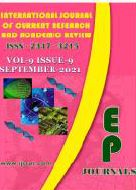Abstract Volume:9 Issue-9 Year-2021 Original Research Articles
 |
Online ISSN : 2347 - 3215 Issues : 12 per year Publisher : Excellent Publishers Email : editorijcret@gmail.com |
2Purulia Medical College and Hospital, West Bengal, India
Stem cells are undifferentiated cells in the body that can self-renew, propagate differentiated cells, and proliferate extensively. They have the capacity and renewing themselves for indefinite periods. The consensus definition of a cancer stem cell arrived as a cell within a tumor that possesses the capacity to self-renew and to cause the heterogeneous lineages of cancer cells that comprise the tumor. The classical model of cancer formation, termed the stochastic model, defines tumor cells as biologically equivalent. Intrinsic factors, such as signaling pathways, levels of transcription factors, and extrinsic factors, result in varied and unpredictable behavior of the tumor cells. Conversely, the hierarchy model proposes that tumors are made up of biologically distinct types of cells with varying functions and behaviors. Tumor growth can only be initiated by a subset of cells known as cancer stem cells (CSCs). CSCs have a set of markers for detection and determination. Surface markers such as ESA, CD44+, are characterized in breast, ovarian, colon, prostate, pancreas or in head and neck cancer tissues while low CD24-, CD 45- found in breast or hepatocellular carcinomas. Micro RNAs (miRNAs) are involved in cancer pathogenesis by posttranscriptional regulation of gene expression. Specific miRNAs play a unique and important regulation role in characteristics of cancer stem cells. In further to find out full nature of the involvement of BCSCs in the molecular mechanisms of tumorigenesis or involvement of micro-RNAs (miRNAs) in the function of BCSCs microarray profiling of miRNAs of both ESA+CD44+CD24-low breast cancer stem cells and MCF7 cell lines were done (45). miRNA expression profiles of BCSCs and MCF-7 cells using a normalisation factor and clustering, identified differentially expressed 19 miRNAs that fell into two groups (fold change ≥ 4). Moreover, miR-301, miR-296, miR-21 and miR-373* have been reported to be expressed in human embryonic stem cells and other stem cells, indicating that these miRNAs may play a constitutive role in maintaining the biological characteristics of stem cells. A detailed understanding of miRNA mechanisms may also permit targeted therapeutic strategies based on miRNA inhibition or supplementation. The present review discuss all about the aspects of cancer stem cells and its identification through different surface markers and differentially expressed micro RNAs. The role of micro RNA up/down regulation is described in brief in this review with aim to take initiative for future onco-genomic research in implication of micro-RNA mediated CSC propagation in tumor metastasis.
How to cite this article:
Suranjana Haldar and Atish Haldar. 2021. Cancer Stem Cells: It’s Future Perspective by Defining its Radiation Sensitivity and Resistivity through Differentially Regulated Expression of Micro-RNAs.Int.J.Curr.Res.Aca.Rev. 9(9): 7-18doi: https://doi.org/10.20546/ijcrar.2021.909.002



Quick Navigation
- Print Article
- Full Text PDF
- How to Cite this Article
- on Google
- on Google Scholor
- Citation Alert By Google Scholar
